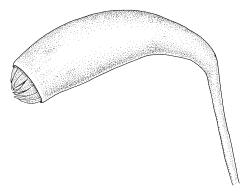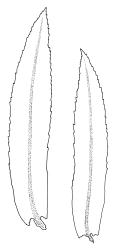- ≡ Hypnum subbasilare Hook., Musci Exot. 1, pl. 10 (1818)
- = Photinophyllum pellucidum Mitt., J. Linn. Soc., Bot. 10: 175 (1868)
Plants medium-sized, yellow-green or bright green, lustrous, forming loose and usually terrestrial turves. Stems erect, unbranched, yellow-brown below, green above, c. 15–25 mm, in cross-section ± angled, with 2 layers of firm-walled, pigmented cells surrounding a parenchymatous cortex and a distinct central strand, sparsely beset below with red to red-brown, smooth rhizoids. Leaves spreading, symmetric, oblong-lanceolate, narrowly acute, not concave, weakly decurrent (especially the base of the costa), scarcely bordered, strongly spinulose-serrate (with teeth either single or ± paired) in upper ⅔, 2.2–3.5 × c. 0.6–0.7 mm, smaller but not scale-like towards the stem base; upper laminal cells lax, oblong-hexagonal, c. 75–120(–150) × 21–30 µm; mostly 3–5:1, with chloroplasts aggregating at cell extremities in dry material, bulging in cross-section, not differentiated below or in alar angles; marginal cells narrower in 1(–2) rows but not forming a distinct border. Costa c. 45 µm wide near base, extending 0.75–0.9 the leaf length, not toothed abaxially, in cross-section (at mid leaf) plano-convex, with few (usually 2) central guide cells, small (≤6-celled) abaxial and adaxial stereid bands and enlarged superficial cells that are similar in shape to the juxtacostal laminal cells.
Autoicous. Perichaetia scattered on lowermost stem, with leaves acuminate from an oblong and yellow base, widely spreading in upper half, costate, to c. 1.8 mm. Perigonia scattered among the perichaetia, brown and bud-like, c. 1 mm long, with bracts c. 0.8 mm, ecostate, and acute from an ovate base, with filiform, 5-celled paraphyses. Setae 24–50 mm, straight, smooth, twisted weakly to the left, pale yellow-brown; capsules horizontal or weakly pendent, oblong-cylindric from an asymmetric and strongly curved base, c. 2.5–3.5 mm, wrinkled below, contracted below the mouth when dry, yellow-brown; exothecial cells mostly oblong-hexagonal, firm- and smooth-walled, mostly 75–105 × 24–30 µm; annulus vesicular, persistent; operculum conic. Peristome double; exostome teeth pale yellow-brown, narrowly lanceolate, inserted close to rim, c. 500–580 µm, bordered, with the outer surface finely and densely papillose (non-striolate) below, more coarsely so above, with the inner surface lamellate; endostome from a high membrane, with keeled and perforate segments nearly as long as the teeth and very long (but fragile) and weakly nodose cilia in groups of 3. Calyptra cucullate, c. 3 mm. Spores ± spherical, 13–16 µm, pale brown, reticulate.
Brotherus 1924, fig. 379 a–e (as G. subbasilare and G. pellucidum); Scott & Stone 1976, pl. 58; Beever et al. 1992, pl. 54; Malcolm & Malcolm 2003, p. 31.
The large, thin-walled laminal cells are easily observed under the hand-lens. The lax areolation, the sharply toothed leaf margins, and the basal perichaetia make this species easily recognisable. In herbarium material the chloroplasts aggregate at both ends of the laminal cells.
Confusion between this species and other members of the Rhizogoniaceae seems unlikely. In the field its habit is suggestive of a Pohlia, but its lax and large laminal cells should prevent confusion with that genus.
NI: S Auckland, Gisborne, Taranaki (Mt Egmont), Wellington. SI: Nelson (Travers Valley, Mt Arthur, Reefton, Paparoa Range), Marlborough (Mt Stokes), Canterbury (49 Mile Peg near Arthur’s Pass), Westland (Camp Creek, Ōtira, Ross), Otago, Southland; St.
Australasian. Tasmania*, mainland Australia*, Argentina*. Reported from Chile by Matteri & Piñero (1987). Reported from Samoa by Mitten (1868), but its occurrence there seems unlikely and was doubted by Schultze-Motel (1974).
On humic soil, rotten wood, and tree fern trunks; less commonly on alluvial silt and often sheltered by overhanging rocks or vegetation. Forming pure turves or mixed with other bryophytes. Although the majority of N.Z. collections are from South I. south of 45º, there is a curious absence of records from Fiordland and the subantarctic islands. Records from the northern half of South I. are mostly from humic soil sheltered by overhanging rocks or vegetation, and nearly (excepting one or two from Marlborough L.D.) all are from areas near to or west of the Main Divide. There are a large number of collections known from the Dunedin region and it is most frequent in the southern portions of South I. and on Stewart I. On North I. ranging from c. 350 (Stubb’s Farm, S Auckland L.D.) to c. 760 m (Mt Kapakapanui, Wellington L.D.). On South I ranging from near sea level (in Otago and Southland L.D.) to c. 1100 m (Paparoa Range, Nelson L.D.); on Stewart I. found up to c. 300 m.










